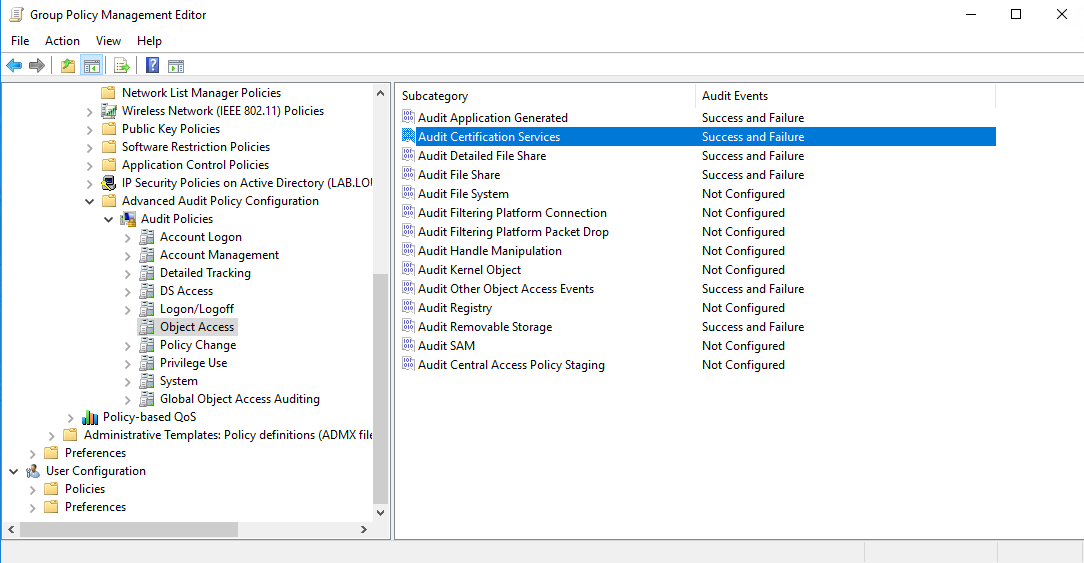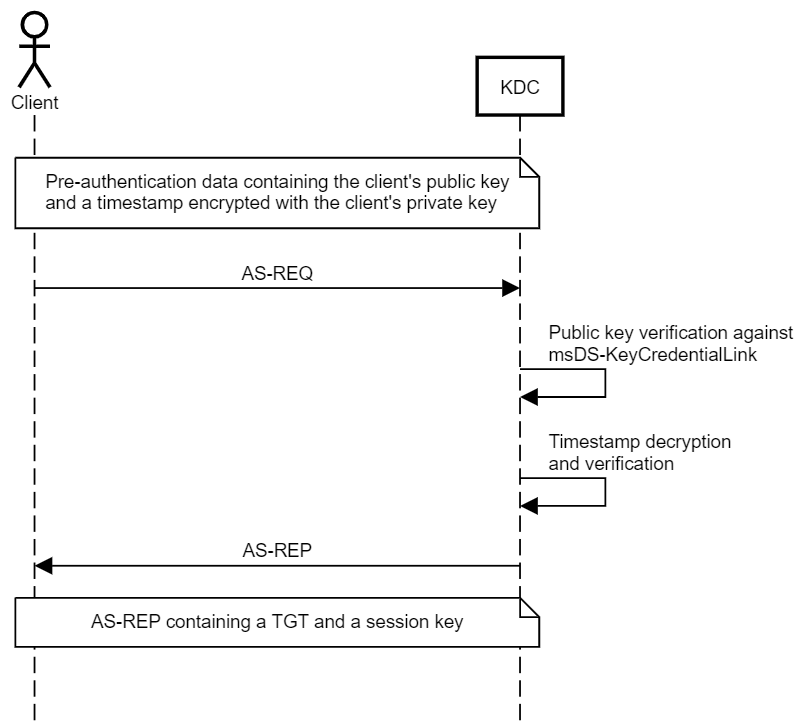Kerberos III - User Impersonation
The goal of this post, whether we are adversaries or defenders, is to help us understand the multiple ways that Kerberos offers to access resources using the credential material gathered.

In the second part of the Kerberos series, we delved into how the Kerberos authentication flow allows the enumeration of domain user accounts and the validation of credentials through the network messages employed by Kerberos. Additionally, it was demonstrated that user credential material can be obtained through the AS-REQ/AS-REP and TGS-REQ/TGS-REP messages. The UnPAC technique was also discussed, which allows for obtaining the NTLM hash of a user authenticated through Kerberos PKINIT as a pre-authentication mechanism.
In this third part, we will explore the techniques for leveraging those credentials for lateral movement, privilege escalation, and persistence methods within the Active Directory environment.
User Impersonation:
Once access to an Active Directory environment is achieved, it is crucial to understand how, as adversaries, the credential material obtained can be used to authenticate through Kerberos and impersonate users. Clear-text passwords, hashes, Kerberos keys, or certificates acquired during an engagement can be leveraged to access new resources within the domain, facilitating lateral movement or privilege escalation. This post will focus on these techniques. Operational Security (OPSEC) concepts will not be covered, as the goal is to understand each method comprehensively. Additionally, brief notes about detection and recommendations have been included for each technique.
Pass the Key / Overpass the Hash
As discussed in the first post of the series, the user must undergo the pre-authentication process before a user can obtain a TGT from the KDC. This pre-authentication mechanism is enabled by default for all accounts within the domain. Still, it can be disabled (ASREPRoast becomes a viable attack path when it is disabled, as described in the second post of the series about credential access). This pre-authentication mechanism requires credential material from the user, meaning any secret keys derived from their password, whether DES, RC4, AES128, or AES256 keys. If we have access to any of these keys, we can request TGTs on behalf of that user.
The only difference between Pass the Key and Overpass the Hash is that Pass the Key uses the user's RC4 key, essentially the NT hash.
From Linux, Impacket's getTGT can be used with the user's NT hash (overpass-the-hash) :
impacket-getTGT -hashes :NTHASH DOMAIN/USER@HOST
The traffic generated is the legitimate TGT request to the KDC (AS-REQ/AS-REP). The following image shows how the user uses the RC4 etype (Kerberos Encryption Type Number 23) to encrypt the timestamp:

And with the user AES key (pass-the-key):
impacket-getTGT -aesKey AESKey DOMAIN/USER@HOST
In line with prior observations, now, the network traffic capture displays the timestamp encrypted using AES256 (Kerberos Encryption Type Number 18):

From Windows, the same action can be performed using Rubeus, asking for a TGT (askTGT) with the user's keys:
.\Rubeus asktgt /domain:DOMAIN /user:USER /enctype:ENCTYPE /aes256:AESKEY /nowrap /ptt
After successfully executing overpass-the-hash / pass-the-key and obtaining a TGT, the next step could involve carrying out pass-the-ticket.
Note:
To obtain the user's hashes from his password in clear, use the hash function of Rubeus:
.\Rubeus.exe hash /password:pass /user:USER /domain:DOMAIN
From the Rubeus documentation, this function will generate the rc4_hmac (NTLM) representation of the password using @gentilkiwi's kerberos:hash (KERB_ECRYPT HashPassword) approach. If user and domain names are specified, the hash forms aes128_cts_hmac_sha1, aes256_cts_hmac_sha1 and des_cbc_md5 are generated. The AES and DES implementations use the user and domain names as salts.
Useful Event IDs & Defenses:
- 4768 – A Kerberos authentication ticket (TGT) was requested. (Encryption Type for RC4/AES128/AES256).
- Monitor unusual login times and atypical locations.
- Service ticket requests that do not follow normal user behavior.
Pass the Ticket / Pass the Cache
Through these techniques, an adversary reuses domain user tickets to inject them into memory and, through the Kerberos authentication flow, gains access to resources/services where the user is authorized without knowing any user credential material.
On Windows hosts, once admin rights are achieved, it is possible to extract the TGTs from the Local Security Authority Subsystem Service (LSASS) process using tools such as mimikatz.
Furthermore, ticket dumping can be performed using Rubeus. As we can read in the Rubeus description:
- Rubeus has no code that touches LSASS (and is not intended to), so its functionality is limited to extracting Kerberos tickets using the LsaCallAuthenticationPackage() API. From a non-elevated point of view, session keys for TGTs are not returned (by default), so only extracted service tickets will be usable (the tgtdeleg command uses a Kekeo trick to get a usable TGT for the current user). If, in a high-integrity context, a GetSystem equivalent is executed using token duplication to elevate to SYSTEM, and a fake login application is registered with the LsaRegisterLogonProcess() API call. This allows privileged enumeration and extraction of all tickets currently registered with LSA on the system, resulting in base64-encoded .kirbi output for later reuse.
Rubeus is employed in an elevated context to enumerate Kerberos tickets in the host:

Confirming the existence of tickets from a privileged user, in this case, a Domain Admin (lares.da), the process continues by dumping the desired ticket for the krbtgt service and the lares.da user:
.\Rubeus.exe dump /service:targetSevice /user:targetUser /nowrap
Creating a “sacrificial session” using the runas command is now advisable since a logon session can only hold a single TGT at a time, and injecting a new TGT into memory would delete the current user's TGT and cause authentication problems.
In the new session, we import the TGT with the Rubeus ptt flag, and we will be able to access the privileged assets:
runas /netonly /user:lareslabs.local\fake powershell.exe
.\Rubeus.exe ptt /ticket:<b64EncondedTicket...>
The ticket can also be used on Linux systems to perform the same technique (Pass-the-Cache).
The Impacket tool 'ticketerConverter' allows the conversion of .kirbi to .ccache format and vice versa, enabling export to the system. This converted ticket can then be used with tools that support Kerberos authentication, like the Impacket suite:
echo "<b64EncodedTicket>" | base64 -d > ticket.kirbi
impacket-ticketConverter ticket.kirbi ticket.ccache
export KRB5CCNAME=ticket.ccache
impacket-<anyScript> -k -no-pass ....
Pass the Certificate
As discussed in the first post of the series, Kerberos I - Overview, every client must go through a ‘pre-authentication’ process before obtaining a Ticket Granting Ticket (TGT) from the KDC, which can be used to get service tickets.
This pre-authentication process can be validated, among other things, by encryption algorithms such as DES, RC4, AES128, or AES256, or in an asymmetric way (public key), using certificates (Public Key Cryptography for initial authentication (PKINIT)).
In short, Pass the Ticket is nothing more than performing Kerberos pre-authentication through PKINIT to obtain a user's TGT, from which we have obtained a valid certificate for authentication.
Below is an example of obtaining a user certificate by abusing the ESC1 misconfiguration in ADCS. Then we perform Pass the Certificate using the “auth” function of certipy:

We have several posts about ADCS misconfigurations in the series “Common ADCS Vulnerabilities: Logging, Exploitation, and Investigation” by Louai Abboud:

In the network traffic, we could see the certificate sent through the AS-REQ type request:

In the same way, the technique can be carried out using asktgt function of Rubeus, indicating the user's certificate. In addition, with the /getcredentials flag, it will perform UnPAC the hash to obtain the user's NT-LM hash:


Useful Defenses:
- Audit Active Directory Certificate Services.
- Remove “Client Authentication” where possible (ADCS).
- Monitor pre-authentication events through PKINIT on non-regular users.
- Event 4768: A Kerberos authentication ticket (TGT) was requested. If the PATYPE is PKINIT, the logon was a smart card logon.
Shadow Credentials:
For compatibility reasons regarding environments where authentication with certificates is not supported, Microsoft introduced the Key Trust concept. In the Key Trust model, authentication is established and validated based on raw data instead of certificates.
In these environments, the public key of the client (either user accounts or machine accounts) is stored in its msDS-KeyCredentialLink attribute.
When the client attempts to pre-authenticate with PKINIT, the KDC will check that the authenticating user knows the private key matching the public key stored in its msDS-KeyCredentialLink multi-value attribute. If there is a match, a TGT will be sent. The value in this attribute is Key Credentials, which are serialized objects that include, among other information, the client's public key.
Shadow Credentials was introduced by Elad Shamir, and as he explains in his post “Shadow Credentials: Abusing Key Trust Account Mapping for Account Takeover”, in case of compromise an account with enough privileges to write that attribute to another domain account (user/machine account), e.g GenericWrite rights, this allows us to create a key pair, append it to the raw public key in the attribute, and gain persistent and stealthy access to the target object.

This attack involves the following requirements:
- A domain that supports PKINIT AND contains at least one Domain Controller running Windows Server 2016 or above.
- A domain where the Domain Controller(s) has its own key pair (for the session key exchange) (e.g. happens when AD CS is enabled or when a certificate authority (CA) is in place).
- Control over an account that can edit the target object's msDs-KeyCredentialLink attribute.
Our post ‘The Phantom Menace: Exposing hidden risks through ACLs in Active Directory’ covers other examples of ACL abuse.

From Linux, pyWhisker, by Charlie Bromberg, provides a way to automate the whole process, from the RSA-peer keys creation to writing to the attribute of the target account.
In the following evidence, it is possible to see, together with ldapmonitor, how the msDS-KeyCredentialLink attribute of the user Darlene has been modified:
pywhisker -d domain -u user -p password --target targetAccount --action add --filename certOutputFile
The following is a brief diagram about Shadow Credentials and how the Key Trust model works:

Once the attack is complete, an adversary can use the certificate to authenticate via PKINIT using Dirkjanm's PKINITools, being able to obtain a TGT to import it later and access services to which Darlene is authorized, or get the NTLM hash via getnthash, as we saw in the first post by requesting a TGS for yourself using Kerberos U2U.
Alternatively, if the Domain Controller does not accept PKINIT authentication (error KDC_ERR_PADATA_TYPE_NOSUPP), it is possible to authenticate with the target account using passthecert. The following example shows the use of PassTheCert with its ldap-shell function:
passthecert.py -action ldap-shell -crt cert.crt -key cert.key -domain domain -dc-ip dcIp
Useful Defenses:
- Audit Directory Service Changes (SACL configured).
- Event - 5136: A directory service object was modified (SACL configured).
- In environments where PKINIT authentication is not standard, the "Kerberos authentication ticket (TGT) was requested" event (4768) may be suspicious when the Certificate Information attributes are not blank.
Playing with (and forging) tickets:
If an adversary compromises a service´s long-term secret key, he can forge tickets or modify them to be legitimate ones. As already discussed, tickets are encrypted with the service's secret key to whom they are targeted.

Note: Microsoft released the security patch KB5008380—Authentication updates in November 2021 to address CVE-2021-42287, aka Kerberos Key Distribution Center (KDC) confusion. This security bypass vulnerability affects the Kerberos PAC and, together with CVE-2021–42278 (sAMAccountName spoofing), allows potential attackers to impersonate domain controllers. This attack is known as noPAC. After that, if the supplied user name does not exist in Active Directory, the KDC will return the error: KDC_ERR_TGT_REVOKED.
The following is an example of forging a Silver Ticket with a user that does not exist (fakeUser) within the domain in an environment with an up-to-date KDC:

Silver tickets:
As discussed in previous posts, services are offered within the Active Directory through machine or service accounts. Acquiring the secret key associated with an account providing a specific service makes it possible to forge Silver Tickets (forged service tickets), impersonating any user for that designated service.
Knowing the secret key (NT hash or RC4/AES keys) of a principal offering a service, it is possible to create a data block just like those found in a legitimate service ticket of a KRB_TGS_REP message, specifying the realm, the intended SPN, the user requesting the service, and its PAC. Once the structure is created, the enc-part block will be encrypted with the compromised secret key.
But... as discussed in the first post of the series, the PAC is double signed, first with the service account secret and a second signature with the krbtgt account secret. So how is it possible to forge the second signature on a service ticket without knowing the krbtgt account secret?, the answer is that it is unnecessary to, since the service (AP server) receives this ticket, it usually verifies only the first signature. This is because service accounts with SeTcbPrivilege, which can act as part of the operating system (e.g. the local SYSTEM account), do not verify the Domain Controller signature. Consequently, this technique presents a more significant challenge for detection than methods such as Golden Ticket, as there is no communication between the service and the KDC for PAC validation. In addition, any registration is limited to the target computer.
The following diagram outlines the process of creating a silver ticket:

The Impacket ticketer script allows forging TGTs/STs from scratch or based on a template (legally requested by KDC). The script will also enable data customization within the PAC_LOGON_INFO, such as groups, extrasids, etc. Ticketer tickets have a lifetime of 10 years from ticket creation.
This process involves leveraging the hash of the service account and specify the ServicePrincipalName (SPN) of the service account. Initially, obtaining the SID of the domain is essential, which can be accomplished, among other methods, using the 'lookupsid' script:
impacket-lookupsid DOMAIN/USER:PASSW@HOST | grep "Domain SID

With the SID of the domain and the hash of the service account, ticketer does the job:
impacket-ticketer -aesKey AESKey -domain-sid DOMAINSID -domain DOMAIN -spn TARGET_SPN -dc-ip DCIP RANDOMNAME

Importing the new ticket allows it to be utilized for the CIFS service:

Analyzing Silver Ticket forging flow in Wireshark reveals that no preceding AS-REQ / AS-REP messages and no TGS-REQ / TGS-REP messages occur; only AP-REQ and (optionally) AP-REP messages are generated, indicating no communication with the Domain Controller.
Furthermore, it can be observed how privileged groups have been added to the PAC:

Likewise, Mimikatz can forge silver tickets through the 'kerberos::golden' function:
mimikatz "kerberos::golden /admin: /domain: /sid: /target: /aes256: /service: /ptt" exit
Typically, machine account passwords rotate every 30 days. So, obtaining the updated secret keys is imperative to create new silver tickets.
Useful Defenses:
- Enable privileged attribute certificate validation of Kerberos. This can assist with the prevention and detection of silver tickets.
- Use a strong password policy for service accounts.
- Enforce user least privilege.
- Audit service accounts.
Golden tickets:
If the secret key of the krbtgt account is compromised (e.g., through complete domain compromise and gaining DCSync rights), ticket-grating tickets (TGTs) signed by the krbtgt account can be forged.
With these TGTs forged with the krbrtgt secret key, an adversary can obtain service tickets and thus obtain permissions for any service, on any machine and as any domain user. Graphically, the flow of this attack would look like the following diagram:

To forge this Golden Ticket, an adversary will need the secret key of the krbtgt account (in this example, the NT hash) and the SID (Security IDentifier) of the domain:

With the krbtgt hash and the domain SID, ticketer script can be used to forge the Golden Ticket. As we mentioned before, in environments with domain controllers updated at least to November 2021, we will need the -user-id of a user that exists within the domain:

ticketer.py -user-id userID -aesKey krbtgtAESKey -domain-sid domainSid -domain domain -dc-ip DCIp domainUser 
The following image illustrates how, when authenticating with Kerberos via psexec, the forged TGT is sent through a TGS-REQ with the privileged groups added to the PAC:

In the same way, from Windows, Rubeus allows this kind of tickets forging through its "golden" function:
.\Rubeus.exe golden /aes256:KRBTGTAESKey /user:domainUser

Useful Defenses:
- Change the KRBTGT account password every 180 days.
- Events 4768 & 4769.
- A possible tactic for detecting the use of golden tickets is to look for TGS-REQs without corresponding AS-REQs.
- Restricting administrative privileges across security boundaries.
- Well-known IOAs associated with Golden Tickets: the default End and Renew time is 10 years minus two days.
Diamond tickets:
Unlike a Golden Ticket, where a new TGT is forged with the hash of the krbtgt account, the Diamond Ticket technique modifies a legitimate TGT issued by a KDC. To do this, the TGT is decrypted using the secret key of the krbtgt account, then modified with the desired fields and re-signed with the key.
The following is a diagram showing the attack flow:

Rubeus performs this attack through its “diamond” function:
.\Rubeus.exe diamond /tgtdeleg /ticketuser:domainUser
/ticketuserid:domainUserID /groups:groupsToAddToPAC /krbkey:KRBRTGTAESKey /ptt

Sapphire tickets:
Created by Charlie "Shutdown", Sapphire tickets are the evolution of Diamond Tickets, stealthier. These are legitimate tickets, but while the Diamond ticket modifies the PAC, the Sapphire ticket replaces it with the PAC of another privileged user.
The way to obtain the legitimate PAC of a privileged user is thanks to S4U2self+u2u.
Although we will see this Kerberos extension in detail in the next post focusing on delegations, here is a brief summary of how these Kerberos extensions work:
S4U2Self Extension: Subprotocol extension to the Kerberos protocol that allows a service to obtain a Kerberos service ticket for a user that has not authenticated to the Key Distribution Center (KDC). S4U includes S4U2proxy and S4U2self. Basically, allows a service to receive the user’s authorization data (e.g the PAC).
For this extension, it is required through the KRB_TGS_REQ:
- Must have at least one Service Principal Name (SPN) to allow the DC to encrypt the generated service ticket with the service secret key.
- Data structure PA_FOR_USER, which contains the information about the user on whose behalf the service requests the service ticket.
- The PAC returned in the service ticket in the following KRB_TGS_REQ contains the authorization data.
U2U Authentication: allows the client to request that the ticket issued by the KDC be encrypted using a session key from a TGT issued to the party that will verify the authentication, basically provides a method to perform authentication when the verifier does not have access to long-term
service key. In order to perform this U2U authentication, the KRB_TGS_REQ needs to contain:
- additional-tickets: field containing the TGT from the secret-key is taken.
- ENC-TKT-IN-SKEY = TRUE : supports user-to-user authentication by allowing the KDC to issue a service ticket encrypted using thesession key from another TGT issued to another user.
- ServiceName (sname) that can refer to an user, not necessarily a service with SPN.
In brief, the following would be the forging flow of a Sapphire Ticket:

The following steps are taken during the Sapphire ticket forging process:
- Obtain the secret keys of
KRBTGTandElliot.A. - Performing the pre-authentication process with a non-privileged user through KRB_AS_REQ message (e.g for
Elliot.A). - The KDC issued a legit TGT.
- Generate a KRB_TGS_REQ with:
- PA_FOR_USER: struc with the impersonated user (e.g Administrator)
- Service name (same): Elliot.A, same user from the 1º step.
- Elliot.A's TGT will be added to the additional-tickets field
- ENC-TKT-IN-SKEY flag set to TRUE (indicates that the ticket for the end server is to be encrypted in the session key from the additional TGT provided).
Analyzing the network traffic, it is possible to identify the mentioned requirements in the KRB_TGS_REQ request:

The PA-FOR-USER padata value is used for the user that wants to impersonate (Administrator). As a snamestring, U2U is employed to obtain a service ticket for an unprivileged user (Elliot.A):

5. Obtain the service ticket for the Administrator using Elliot.A as sname, through TGS-REP response:

6. Forge the sapphire ticket, replacing Elliot.A's original PAC using the ST PAC of Administrator + match the cname with "Administrator".
From Windows hosts, at the date of writing this post, it has not been possible to replicate this attack, but ticketer could run it again on Linux:
ticketer.py -nthash krbtgtNTHash -request -impersonate 'Administrator' -domain 'domain' -user 'domainUser' -password 'Password123' -aesKey 'krbtgtAESKEY' -domain-sid 'domainSID' -dc-ip dcIP 'justignored'
Once imported in the KRB5CCNAME environment variable, we will be able to access using any tool that accepts kerberos authentication:

Wrapping things up …
In this third part of the Kerberos series, we’ve dug a little deeper into the Kerberos user impersonation techniques. The goal with this post, whether we are adversaries or defenders, is to understand the multiple ways that Kerberos offers us to access resources using the credential material gathered.
We hope this installment of the Kerberos series has helped you better understand the number of techniques adversaries can use to attack the Kerberos authentication protocol.
In the next post of the series, we will continue to delve deeper, next time looking at ‘Kerberos Delegations’ and talking about how this setting allows applications to request end-user access credentials to access resources on behalf of the originating user and how an adversary would benefit from this flow.
Resources:
- Alva Duckwall & Benjamin Delpy - Abusing Microsoft Kerberos: Sorry You Guys Don't Get It.
- Netwrix - Exploiting Service Accounts.
- Adsecurity - Mimikatz and Active Directory Kerberos Attacks.
- Unit42 - The New Generation of Kerberos Attacks.
- Fortra - Impacket - We love playing tickets.
- Overpass-the-Hash Attack: Principles and Detection.
- Elda Shamir - Shadow Credentials.
- Atl4s - Understanding - or at least, trying to.
- Peter Gabaldon - Diamond and Sapphire Tickets.
- Tarlogic - Kerberos.
- Packt - NoPac Vulnerability.
- Cyberstoph - Detecting shadow credentials.
- GhostPack - Rubeus.
- Splunk - Detecting Active Directory Kerberos Attacks.



